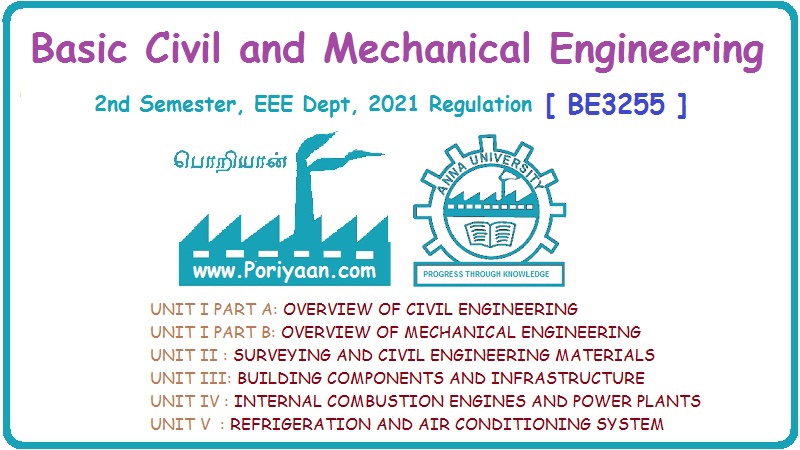Basic Civil & Mechanical Engineering: UNIT I: c. Construction engineering
Construction engineering
Overview of civil engineering
Construction technology is a related field that deals more with the practical aspects of projects.
UNIT – I
Chapter - 1. (B)
CONSTRUCTION ENGINEERING
1. BUILDING CONSTRUCTION
Construction
technology is a related field that deals more with the practical aspects of
projects. Construction technologists or construction technicians learn some of
the design aspects similar to civil engineers and some of the project site
management aspects similar to construction managers. These technicians are
unique such that they are a cross between civil engineers and construction
managers. An overview of various aspects pertaining to building construction is
presented in this section.
A
building can be divided into substructure (foundation) and superstructure, the
plinth being the dividing line between them. The superstructure of a building
is the portion of the structure above the foundation. In building construction,
attention is paid as to how the civil works are carried out in the field after
they have been planned by an architect and structurally designed by an engineer.
All
buildings have the same components such as foundation, walls, floors and roof.
In addition, they are decorated with plastic, paint, etc. to make them
aesthetically beautiful. These items of building works are called civil works.
Water and electricity have also to be supplied to the buildings to make them
habitable. These items are called building services.
When
planning buildings in cities, towns and municipalities in India, rules and
regulations • have to be met. For example, enough space is to be left around
the building for ventilation.
1. SITE PREPARARTION
The
first work to be undertaken before the actual construction of a building is
checking the dimensions of its boundaries once the site is made available for
construction. The vital boundary stones should be in their position and they
should be checked with reference to the survey plan.
Site
Layout: It consists of the layouts of the access roads,
sheds, etc.
Site
Clearing: Site clearing means any one or all of the following
works:
(i)
Surface cleaning of grass, trees, anthills, hillocks, etc.
(ii)
Cleaning of obstructions which may be above or below the ground level. The obstructions
may be old drainage works, old septic tanks, soak pits etc.
(iii)
Cleaning of the obstructions belonging to other organisations such as drainage
or water supply lines, underground electric or telephone cables
Enclosing
the Site: The building site needs to be enclosed for public
safety.
Water
Supply for Construction: Water is an important building
material. If groundwater is available, it should be tested suitably for various
uses. The cost of water comes to about one or two percent of the cost of
the civil works. If ground water is not available, water connection can be
obtained from municipal authorities.
Electrical
Supply: Electricity supply is necessary for building works.
The following aspects need attention:
(i)
Cables should be of good quality and suitable supported.
(ii)
The switch board, etc., must be properly enclosed and capable of being locked.
(iii)
The switch board should be about 1.5 m above the ground level.
2. EARTHWORK
Excavation:
Excavation for the foundation is part of earthwork that comes after site
preparation. For a building having a basement, the whole area in the plan of
the building has to be excavated to the desired depth. For column footings,
excavation is made only around the column. The earthworks are classified into
the following categories:
(i)
Soft/loose soil
(ii)
Hard/dense soil
(iii)
Ordinary rock not requiring blasting
(iv)
Hard rock where blasting is allowed
(v)
Hard rock where blasting is not allowed
Filling:
Another major item of the earthwork is earth filling. After construction of the
foundation and the walls to a height above the ground level, vacant spaces are
to be refilled to the original surface of the ground with approved materials.
The filling earth should be devoid of clods and should be watered and rammed.
The
purpose of sand filling under floors is to break the upward movement of
capillary water under the floors. It can lead to floor sweating of the ground
floor during rainy season. Sand filling also reduces settlement of floors.
Finally, earth filling around the building is required as part of earthwork.
3. COMPONENTS OF BUILDING
The
major components of building are the following:
1.
Foundation (Details explained in Chapter 5)
2.
Superstructure Details explained in Chapter 6)
Bulldozers
for site clearance and equipment such as concrete mixer, concrete pump, bar
bending machine, hoists for lifting materials and pumps are used in civil
engineering construction. A study on the selection of the type and quantity of
appropriate equipment needed for a large project is also part of construction
engineering.
Basic Civil & Mechanical Engineering: UNIT I: c. Construction engineering : Tag: : Overview of civil engineering - Construction engineering
Related Topics
Related Subjects
Basic Civil and Mechanical Engineering
BE3255 2nd Semester 2021 Regulation | 2nd Semester EEE Dept 2021 Regulation
